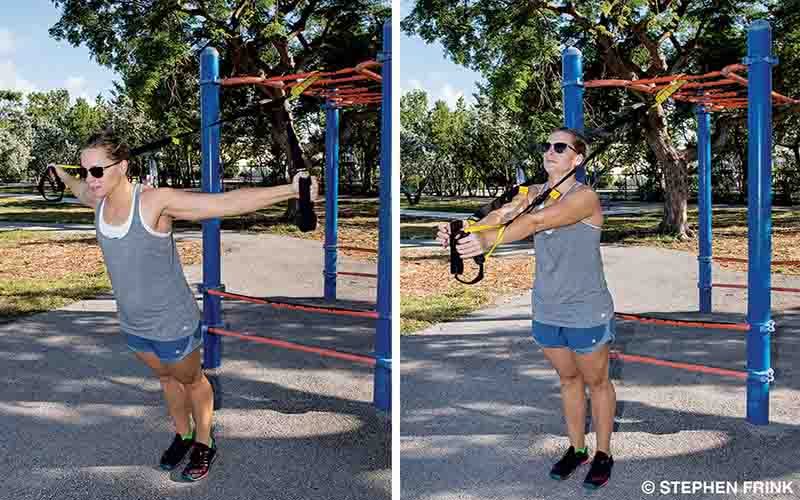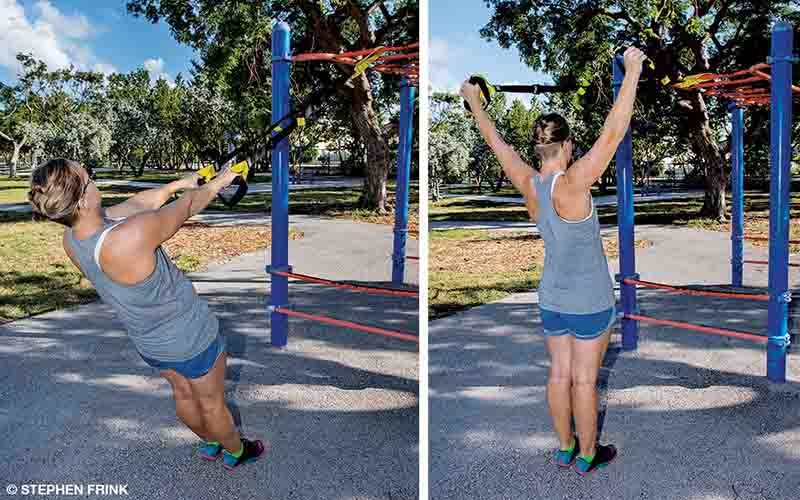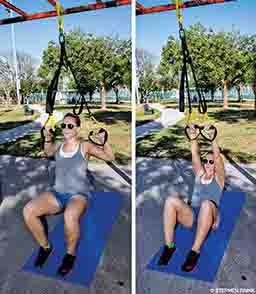If you do not have access to a pool this winter but want to maintain — or even improve — your strength and stamina in the water, suspension bands may be just the thing.
TRX®, the best-known suspension-training system, can be purchased for $100-$300, but other suspension bands can be found for $60 or less.
Chest Flies

Chest flies are a great way to work your upper body, especially your chest. The chest muscles play a key role in your freestyle pull while swimming, so keeping up their strength is a great way to ensure you can capably move through the water. This exercise will also improve your ability to pull yourself up into a boat from the water.
- Face away from the point at which the suspension bands are connected, and plant your feet in a stable, athletic stance.
- Reach behind you and grab the handle of a band with each hand, extend your arms straight out at shoulder height, and walk forward until there is no slack in the bands.
- Walk your feet backward a few steps until you feel a good stretch and so your body leans forward a bit.
- With your palms facing each other, bring your arms together in front of your body, keeping them at shoulder height.
- As you move your arms close to each other you will notice you are pushing your body upward toward a more vertical position.
Start by doing three sets of 10 chest flies, three or four times per week.
Overhead Shoulder Raises

The overhead shoulder raise, another great exercise to work your upper-body muscles, focuses on the shoulders, upper back and deltoids. This exercise promotes freestyle and backstroke pulling power and thus efficient movement through the water.
- Begin by standing and facing the bands.
- Grab a handle in each hand, extend your arms out in front of you and walk backward to take the slack out of the bands.
- Engage your core, maintain tension on the bands, and walk your feet forward so your body naturally reclines.
- Make sure your palms are facing down and your arms are fully extended forward.
- Raise your arms over your head, which will bring your body into more of a standing position. Remember to keep your core tight.
- Raise your arms straight above your head with your palms facing forward until you are standing straight up.
Start by doing three sets of eight overhead shoulder raises, three or four times per week.
Assisted Pull-Ups

The assisted pull-up works your back muscles, which enhance your freestyle pulling power.
- Sit on the ground under the bands. The handles should be high enough off the ground that you must extend your arms above your head to reach them.
- Bend your knees, and place both feet flat on the ground in front of you.
- When you extend your hands over your head, your palms should face forward, and there should be a straight line from your hands to your hips.
- Press your feet into the ground, and pull yourself up (head first) toward the handles with your head between them.
- As you pull yourself up, try to maintain a straight line from your hands to your hips. Finish in a squatting position with your elbows bent and your upper and lower back engaged. Lower yourself slowly to the start position, and repeat.
Start by preforming three sets of 10 assisted pull-ups, three or four times per week.
Hip Extensions

Hip extensions help to maintain core and leg strength when you are out of the water for a while. Use a yoga mat to make this exercise more comfortable.
- Lie on your back on the mat with your heels in the suspension bands’ loops (the loops are usually connected to the handles).
- Place your hands out to the sides with your palms down, bend your knees, and push your heels into the loops to drive your hips toward the sky. Squeeze your buttocks the entire time.
- The final position of this exercise is a straight line from your knees to your head. From there, slowly lower your hips, and repeat.
Start by doing three sets of 15 hip extensions, three or four times per week.
Hip Adductions

Hip adductions build core, hip and leg strength. Strong hip adductors allow you to forcefully snap your feet together, providing greater breaststroke kicking power.
- Start by lying down on a mat and resting your heels in the suspension bands’ loops. Straighten your legs, and flex your toes toward your head.
- Put your hands out at your sides, palms down, and lift your hips off the ground.
- With your hips elevated, slowly separate your legs, moving them apart while keeping your toes flexed.
- The final position of this exercise is a V shape in your legs with your toes flexed and your hips off the ground.
- Keep your hips off the ground as you slowly bring your legs back together, and repeat.
Start by doing three sets of eight hip adductions, three to four times per week.
As you get comfortable performing these exercises, add three to five repetitions per set and one or two additional sets per week.
NOTE: To avoid an increased risk of decompression sickness, DAN® recommends that divers avoid strenuous exercise for 24 hours after making a dive. During your annual physical exam or following any changes in your health status, consult your physician to ensure you have medical clearance to dive.
| © Alert Diver — Q1 2018 |